Gas Chamber at Dachau Beginning in February 1942, Jews in Germany and the German-occupied countries were rounded up by the Nazis and deported to the East, according to plans made at the Wannsee Conference on January 20, 1942. In April 1942, the decision was made to build a new crematorium with four ovens at Dachau; four disinfection chambers and a homicidal gas chamber were to be included in the new building which was to be called Baracke X. On the blueprints for Baracke X, the homicidal gas chamber was called a shower room, but each of the four disinfection chambers was called a Gaskammer, the German word for gas chamber. An order was issued from Berlin on July 23, 1942 to begin construction of Baracke X at a cost of 150,000 Reichsmark. By the time that Baracke X was finished in 1943, millions of European Jews had already been killed in the gas chambers at Treblinka, Belzec and Sobibor after being transported to the East, and millions more were destined to be sent to the death camps at Auschwitz and Majdanek. Dachau was mainly a camp for Communist political prisoners, anti-Fascist resistance fighters, most of whom were Catholic, and Soviet POWs. The photograph above, taken in May 2007, shows Baracke X, the building where the infamous Dachau gas chamber is located. On the left in the photo above, behind the recently-added white table, are the two bins on the outside wall through which Zyklon-B poison gas pellets could be poured into the gas chamber. The openings for the bins, which were formerly hidden behind a three-sided wooden screen that was attached to the wall, were centered on the inside wall of the gas chamber. A small rectangular hole between the two bins has been boarded up and there is no corresponding hole on the inside of the gas chamber. The photo below shows the outside wall of the gas chamber with the two bins and the boarded up hole. 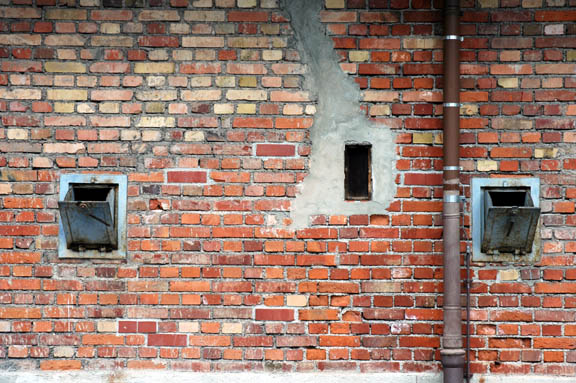 When American soldiers of the US Seventh Army arrived on April 29, 1945 to liberate the concentration camp at Dachau, they found that the inmates in the camp, who were predominantly Communists and other anti-Nazi political prisoners, had organized into an International Committee, headed by a Belgian medical doctor named Albert Guérisse, who was a captured British SOE agent. Guérisse was using the fake name of Patrick O'Leary and pretending to be Canadian. Patrick O'Leary spoke perfect English and he and his fellow Committee members were very anxious to give a guided tour of the camp to the American liberators and the newspaper reporters who accompanied them. They particularly wanted to show them the five gas chambers outside the prison compound in the new crematorium building, named Baracke X. Many of the soldiers and newspaper reporters who took this tour wrote their descriptions of the gas chambers, but none of them mentioned the bins on the outside wall. The photo below shows how Baracke X looked a day or two after the Dachau concentration camp was liberated. The bins, used for pouring the poison gas pellets into the gas chamber, are located behind the wooden structure shown in the center of the photo.  On April 30, 1945, the day after the liberation of the camp, a U.S. Army Signal Corps photographer took a picture of a gas chamber door with the word "Gaszeit" written on it. No explanation was given for how the victims were persuaded to go through a door with the word "Gaszeit" (Gas Time) on it, nor why the largest of the five gas chambers at Dachau had the word "Brausebad" (Shower Bath) written above the door in order to fool the victims. The US Army Signal Corps photo below was published in American newspapers and magazines and was then shown in a traveling exhibit which started in St. Louis and ended in Washington, DC.  The U.S. Seventh Army's caption on the photo above reads as follows: Gas chambers, conveniently located to the crematory, are examined by a soldier of the U.S. Seventh Army. These chambers were used by Nazi guards for killing prisoners of the infamous Dachau concentration camp. 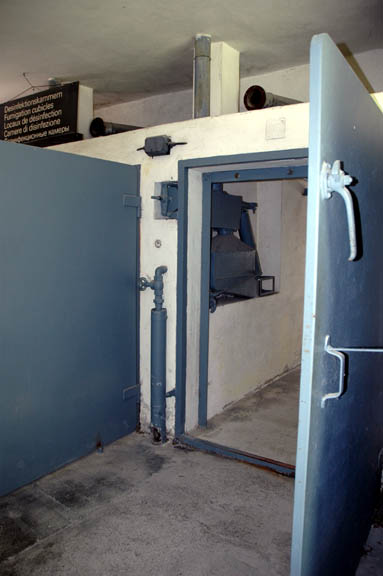 On the right in the photo above, taken in May 2007, is the same door that is shown in the 1945 photo above. This door, which opens into the disinfection chamber shown in the center of the photo, has been bolted to another door. On the left is another door into one of the four disinfection chambers at Dachau. A sign above the door on the left tells visitors that these are disinfection chambers. The original Report of the Atrocities Committed at Dachau Concentration Camp, signed by Col. David Chavez, Jr., JAGD, 7 May 1945, made no mention of the bins and described the screen as a "Wooden shed believed to contain a pump or compressor." The wording of the Report implies that no one went into the "wooden shed" to see if the pump or compressor "believed" to be hidden there was actually there. The Chavez Report was entered into the Nuremberg International Military Tribunal as Documents 159L and 2430-PS; an undated addendum to the original Report mentions the bins. On November 29, 1945, a film was shown at the Nuremberg International Military Tribunal which included footage of the gas chamber, but the east wall of the homicidal gas chamber where the openings for the bins are located was not shown. Instead, the film showed the shower heads and the "top vents" through which the gas was put into the chamber.  On April 30, 1945, the day after the Dachau concentration camp was liberated, the 40th Combat Engineer Regiment, which was supporting the 45th Thunderbird Division, arrived to take over. The photo above shows Eldon Patterson of E Company, 40th Combat Engineers standing in front of Baracke X. The door into the "wooden shed" was blocked by a pile of corpses and it may even have been nailed shut which would have discouraged anyone from looking behind it. 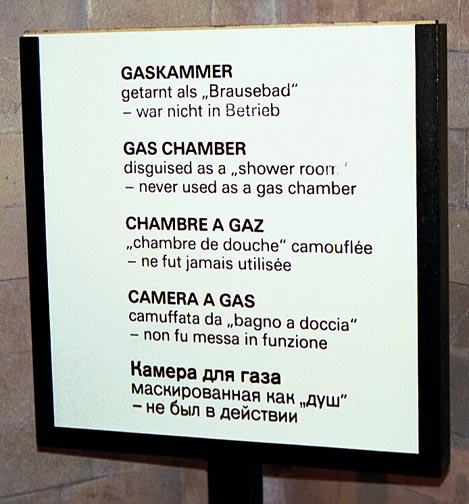 In May 1965, a portable sign, which said in 5 languages that it was never used as a gas chamber or never put into operation, was placed in the Dachau gas chamber when a Memorial Site on the grounds of the former concentration camp was first opened to the public. This sign was still there in May 2001, but by May 2003, it had been removed. The English version reads: Gas Chamber disguised as a "shower room" - never used as a gas chamber. This implies that the room may have been used for something other than a gas chamber. When the American liberators arrived on April 29, 1945, the Baracke X building had been in existence for two years but the room marked "Brausebad" had allegedly never been used as a gas chamber. The undressing room, next to the Brausebad, was furnished with soap and fresh towels, indicating that the "gas chamber" might have been used as a shower room, except that the shower heads, as seen today, are not connected to water pipes. If the room marked "Brausebad" was not used for gassing, nor for showers, this means that three rooms (the waiting room, undressing room and shower room) were not used for anything for two years, yet in the midst of all the chaos in the camp in the last days of the war, soap and towels were still kept in the undressing room so that the American liberators would not suspect that the shower room was really a homicidal gas chamber. If the shower heads in the Brausebad had been hooked up to water pipes, the heat of the cremation ovens in the Baracke X building could have been used to heat water for the shower, as was done at the Natzweiler camp. The gas chamber at Natzweiler was in a separate building, not in the shower room in the crematorium, as at Dachau. 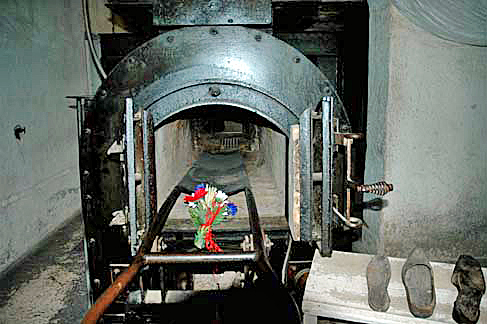 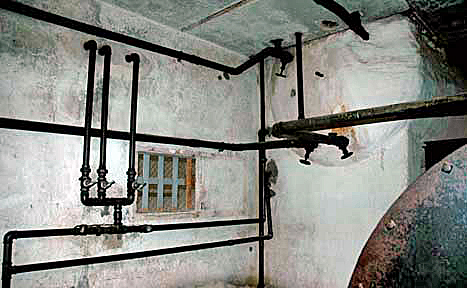 According to Sgt. Scott Corbett, a correspondent for the official 42nd Division newspaper who was at Dachau on the day it was liberated, the SS staff had set a time bomb to blow up the gas chamber after they abandoned the camp on April 28th, the day before the American liberators arrived. The following quote is from an article written by Sgt. Scott Corbett for the Rainbow Reveille, the 42nd Division Newspaper. This excerpt from Scott Corbett's article is included on page 42 of the book entitled "Dachau 29 April 1945, the Rainbow Liberation Memoirs, Edited by Sam Dann": The first human beings ever to enter the infamous Concentration Camp at Dachau without despair and terror, entered it today. Infantry men of the XVth Corps, 42nd Division, are now in command of Dachau and they brought a new life to over 30,000 survivors among the prisoners of the horror camp. What they found there bears out every atrocity told about the first great concentration camp in 12 years of its existence. In the crematorium, the skeleton-like bodies of the dead still lay in a room next to the furnace, stacked like cordwood. The cement floor slanted to a drain which carried off the blood, but not the unforgettable stench of death. Unlike Auschwitz, where the Gas Chamber and the Crematorium were demolished by the retreating SS, the destruction of this horrifying evidence at Dachau by a time bomb was prevented when doughboys discovered and severed the wire which would have set off the charge. In addition, the entire building was a maze of booby-traps. 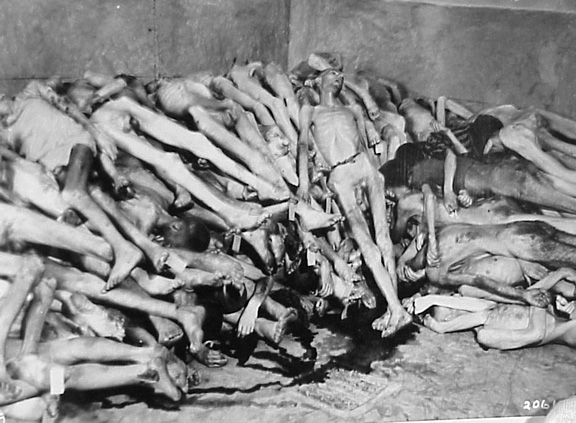 The photo above shows that the morgue at Dachau had a floor drain, but there were no water pipes in the room. The water to clean the morgue came from a water pipe on the wall near the floor of the "gas chamber" which has six floor drains, although the drains, as seen today, are closed. Sgt. Corbett was apparently very well informed about the Nazi atrocities since he knew that the SS had previously destroyed the gas chamber evidence at Auschwitz after they abandoned the camp in January 1945, possibly with time bombs set to go off after they left. In 1948, the "Lachout document" stated the following regarding the gas chamber at Dachau and other camps: The Allied Investigation Commission
has established so far In all these cases it could be proved
that the confessions By May 2003, the sign in the gas chamber had been removed and the Museum staff was telling visitors that the gas chamber had been used only a few times for gassing prisoners. Some of the Dachau tour guides tell visitors that Dr. Sigmund Rascher experimented with gassing Russian POWs with Zyklon-B in the Dachau gas chamber. Other tour guides tell visitors that the Dachau gas chamber was used to train SS men in how to gas the Jews. Official Army Report on gas chamberEvidence of gassingBack to Gas Chamber indexHomeThis page was last updated on October 13, 2009 |